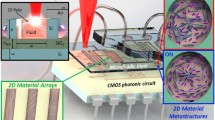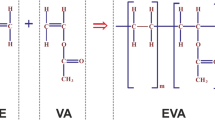Abstract
This article reports on a detailed investigation of sol–gel processed hybrid organic–inorganic materials for use in lab-on-a-chip (LoC) applications. A particular focus on this research was the implementation of integrated microfluidic circuitry in waveguide-based photonic sensing platforms. This objective is not possible using other fabrication technologies that are typically used for microfluidic platforms. Significant results on the surface characterisation of hybrid sol–gel processed materials have been obtained which highlight the ability to tune the hydrophilicity of the materials by careful adjustment of material constituents and processing conditions. A proof-of-principle microfluidic platform was designed and a fabrication process was established which addressed requirements for refractive index tuning (essential for waveguiding), bonding of a transparent cover layer to the device, optimized sol–gel deposition process, and a photolithography process to form the microchannels. Characterisation of fluid flow in the resulting microchannels revealed volumetric flow rates between 0.012 and 0.018 μl/min which is characteristic of capillary-driven fluid flow. As proof of the integration of optical and microfluidic functionality, a microchannel was fabricated crossing an optical waveguide which demonstrated that the presence of optical waveguides does not significantly disrupt capillary-driven fluid flow. These results represent the first comprehensive evaluation of photocurable hybrid sol–gel materials for use in waveguide-based photonic platforms for lab-on-a-chip applications.













Similar content being viewed by others
References
Avellaneda CO, Dahmouche K, Bulhoes LOS (2002) All sol-gel electrochromic smart windows: CeO2-TiO2/Ormolyte. Mol Cryst Liquid Cryst 374:113–118
Avendano E, Berggren L, Niklasson GA, Granqvist CG, Azens A (2006) Electrochromic materials and devices: brief survey and new data on optical absorption in tungsten oxide and nickel oxide films. Thin Solid Films 496(1):30–36
Bao JB, Harrison DJ (2006) Measurement of flow in microfluidic networks with micrometer-sized flow restrictors. AICHE J 52(1):75–85
Basabe-Desmonts L, Benito-Lopez F, Gardeniers HJGE, Duwel R, van den Berg A, Reinhoudt DN, Crego-Calama M (2008) Fluorescent sensor array in a microfluidic chip. Anal Bioanal Chem 390(1):307–315
Becker H, Heim U (2000) Hot embossing as a method for the fabrication of polymer high aspect ratio structures. Sensors Actuators A Phys 83(1–3):130–135
Besanger TR, Brennan JD (2006) Entrapment of membrane proteins in sol-gel derived silica. J Sol-Gel Sci Technol 40(2–3):209–225
Bhattacharya S, Datta A, Berg JM, Gangopadhyay S (2005a) Studies on surface wettability of poly(dimethyl) siloxane (PDMS) and glass under oxygen-plasma treatment and correlation with bond strength. J Microelectromech Sys 14(3):590–597
Bhattacharya S, Datta A, Berg JM, Gangopadhyay S (2005b) Studies on surface wettability of poly(dimethyl) siloxane (PDMS) and glass under oxygen-plasma treatment and correlation with bond strength. J Microelectromech Syst 14(3):590–597
Birnie DP (2004) Surface skin development and rupture during sol-gel spin-coating. J Sol-Gel Sci Technol 31(1–3):225–228
Buso D, Della Giustina G, Brusatin G, Guglielmi M, Martucci A, Chiasera A, Ferrari M, Romanato F (2009) Patterning of sol-gel hybrid organic-inorganic film doped with luminescent semiconductor quantum dots. J Nanosci Nanotechnol 9(3):1858–1864
Copperwhite R, Oubaha M, Versace DL, Croutxé-Barghorn C, MacCraith BD (2008) The role of photoinitiator and chelating agent in the fabrication of optical waveguides from UV-photocurable organo-mineral sol–gel materials. J Non-Cryst Solids 354(30):3617–3622
Coudray P, Etienne P, Porque J, Moreau Y, Najafi SI (1998) Integrated optical devices achieved by sol-gel process, integrated optics devices II. The International Society for Optical Engineering, San Jose, p 252
De Malsche W, Clicq D, Verdoold V, Gzil P, Desmet G, Gardeniers H (2007) Integration of porous layers in ordered pillar arrays for liquid chromatography. Lab Chip 7(12):1705–1711
Edwards TL, Mohanty SK, Edwards RK, Thomas CL, Frazier AB (2002) Rapid micromold tooling for injection molding microfluidic components. Sensors Mater 14(3):167–178
Efimenko K, Wallace WE, Genzer J (2002) Surface modification of sylgard-184 poly(dimethyl siloxane) networks by ultraviolet and ultraviolet/ozone treatment. J Colloid Interf Sci 254(2):306–315
Everaert EP, Vandermei HC, Devries J, Busscher HJ (1995) Hydrophobic recovery of repeatedly plasma-treated silicone-rubber.1. Storage in air. J Adhes Sci Technol 9(9):1263–1278
Everaert EP, VanderMei HC, Busscher HJ (1996) Hydrophobic recovery of repeatedly plasma-treated silicone rubber.2. A comparison of the hydrophobic recovery in air, water, or liquid nitrogen. J Adhes Sci Technol 10(4):351–359
Faustini M, Vayer M, Marmiroli B, Hillmyer M, Amenitsch H, Sinturel C, Grosso D (2010) Bottom-up approach toward titanosilicate mesoporous pillared planar nanochannels for nanofluidic applications. Chem Mater 22(20):5687–5694
Fois E, Gamba A, Tabacchi O (2008) Influence of silanols condensation on surface properties of micelle-templated silicas: a modelling study. Microporous Mesoporous Mater 116(1–3):718–722
Fujii T (2002) PDMS-based microfluidic devices for biomedical applications. Microelectron Eng 61–2:907–914
Gupta R, Chaudhury NK (2007) Entrapment of biomolecules in sol-gel matrix for applications in biosensors: problems and future prospects. Biosens bioelectron 22(11):2387–2399
Hamdy AS (2006) Advanced nano-particles anti-corrosion ceria based sol gel coatings for aluminum alloys. Mater Lett 60(21–22):2633–2637
Hannes B, Vieillard J, Chakra EB, Mazurczyk R, Mansfield CD, Potempa J, Krawczyk S, Cabrera M (2008) The etching of glass patterned by microcontact printing with application to microfluidics and electrophoresis. Sensor Actuators B Chem 129(1):255–262
Higgins C, Wencel D, Burke CS, MacCraith BD, McDonagh C (2008) Novel hybrid optical sensor materials for in-breath O-2 analysis. Analyst 133(2):241–247
Ho JA, Zeng S, Tseng W, Lin Y, Chen C (2008) Liposome-based immunostrip for the rapid detection of Salmonella. Anal Bioanal Chem 391(2):479–485
Hwang T, Lee H, Kim H, Kim G (2010) Two layered silica protective film made by a spray-and-dip coating method on 304 stainless steel. J Sol-Gel Sci Technol 55(2):207–212
Iliescu C (2006) Microfluidics in glass: technologies and applications. Informacije Midem-J Microelect Elect Comp Mater 36(4):204–211
Jaynes WF, Boyd SA (1991) Hydrophobicity of siloxane surfaces in smectites as revealed by aromatic hydrocarbon adsorption from water. Clays Clay Mineral 39(4):428–436
Jiang HW, Kakkar AK (1999) An alternative route based on acid-base hydrolytic chemistry to NLO active organic-inorganic hybrid materials for second-order nonlinear optics. J Am Chem Soc 121(15):3657–3665
Karuppasamy A, Subrahmanyam A (2007) Studies on electrochromic smart windows based on titanium doped WO3 thin films. Thin Solid Films 516(2–4):175–178
Kribich KR, Barry H, Copperwhite R, Kolodziejczyk B, O’Dwyer K, Sabattie JM, MacCraith BD (2004) Thermo-optic switches using sol-gel processed hybrid materials. Proc SPIE 5451:518
Kribich K, Copperwhite R, Barry H, Kolodziejczyk B, Sabattie JM, O’Dwyer K, MaCCraith B (2005) Novel chemical sensor/biosensor platform based on optical multimode interference (MMI) couplers. Sens Actuators B Chem 107(1):188–192
Lei BF, Li B, Zhang HR, Lu SZ, Zheng ZH, Li WL, Wang Y (2006) Mesostructured silica chemically doped with Ru-II as a superior optical oxygen sensor. Adv Func Mater 16(14):1883–1891
Liu RH, Stremler MA, Sharp KV, Olsen MG, Santiago JG, Adrian RJ, Aref H, Beebe DJ (2000) Passive mixing in a three-dimensional serpentine microchannel. J Microelectromech Sys 9(2):190–197
Lynn NS, Dandy DS (2009) Passive microfluidic pumping using coupled capillary/evaporation effects. Lab Chip 9(23):3422–3429
Mescher MJ, Swan EEL, Fiering J, Holmboe ME, Sewell WF, Kujawa SG, McKenna MJ, Borenstein JT (2009) Fabrication methods and performance of low-permeability microfluidic components for a miniaturized wearable drug delivery system. J Microelectromech Syst 18(3):501–510
Najafi SI, Touam T, Sara R, Andrews MP, Fardad MA (1998) Sol-gel glass waveguide and grating on silicon. J Lightwave Technol 16(9):1640–1646
Oubaha M, Smaihi M, Etienne P, Coudray P, Moreau Y (2003) Spectroscopic characterization of intrinsic losses in an organic-inorganic hybrid waveguide synthesized by the sol-gel process. J Non-Cryst Solids 318(3):305–313
Oubaha M, Kribich R, Copperwhite R, Etienne P, OÕDwyer K, MacCraith B, Moreau Y (2005) New organic inorganic sol–gel material with high transparency at 1.55 lm. Opt Commun 253:346–351
Oubaha M, Copperwhite R, Murphy B, Kolodziejczyk B, Barry H, O’Dwyer K, MacCraith BD (2006) Development of photo-patternable organo-mineral hybrid films from the sol-gel condensation of alkoxysilanes. Thin Solid Films 510(1–2):334–338
Ovsianikov A, Chichkov B, Mente P, Monteiro-Riviere NA, Doraiswamy A, Narayan RJ (2007) Two photon polymerization of polymer-ceramic hybrid materials for transdermal drug delivery. Int J Appl Ceramic Technol 4(1):22–29
Ovsianikov A, Viertl J, Chichkov B, Oubaha M, MacCraith B, Sakellari L, Giakoumaki A, Gray D, Vamvakaki M, Farsari M, Fotakis C (2008) Ultra-low shrinkage hybrid photosensitive material for two-photon polymerization microfabrication. Acs Nano 2(11):2257–2262
Porque J, Coudray P, Charters R, Kribich K, Etienne P, Moreau Y (2000) WDM based on multimode interference-coupler built in an organic-inorganic material. Opt Commun 183(1–4):45–49
Serbin J, Egbert A, Ostendorf A, Chichkov BN, Houbertz R, Domann G, Schulz J, Cronauer C, Frohlich L, Popall M (2003) Femtosecond laser-induced two-photon polymerization of inorganic-organic hybrid materials for applications in photonics. Opt Lett 28(5):301–303
Varma PCR, Colreavy J, Cassidy J, Oubaha M, McDonagh C, Duffy B (2010) Corrosion protection of AA 2024–T3 aluminium alloys using 3,4-diaminobenzoic acid chelated zirconium-silane hybrid sol-gels. Thin Solid Films 518(20):5753–5761
Versace DL, Oubaha M, Copperwhite R, Croutxé-Barghorn C, MacCraith BD (2008) Waveguide fabrication in UV-photocurable sol–gel materials: influence of the photoinitiating system. Thin Solid Films 516(18):6448–6457
Zhang HX, Lu D, Fallahi M (2004) Active organic-inorganic sol gel with high thermal stability for nonlinear optical applications. Appl Phys Lett 84(7):1064–1066
Zhu Y, Petkovic-Duran K (2010) Capillary flow in microchannels. Microfluid Nanofluid 8(2):275–282
Acknowledgments
The authors wish to thank CIBA Specialty Chemicals Corporation for having generously provided the Irgacures photoinitiators employed in this study, and gratefully acknowledge the financial support of Enterprise Ireland under the “Commercialisation Fund Technology Development” project Multibiosense (TD/08/309).
Author information
Authors and Affiliations
Corresponding author
Rights and permissions
About this article
Cite this article
Copperwhite, R., O’Sullivan, M., Boothman, C. et al. Development and characterisation of integrated microfluidics on waveguide-based photonic platforms fabricated from hybrid materials. Microfluid Nanofluid 11, 283–296 (2011). https://doi.org/10.1007/s10404-011-0795-4
Received:
Accepted:
Published:
Issue Date:
DOI: https://doi.org/10.1007/s10404-011-0795-4




